
Movements is a 1959 five-movement work for piano and orchestra by Igor Stravinsky lasting about ten minutes. It was written during his serial period [1] and shows his dedication to that idiom as well as the influence of Anton Webern. [2]

Movements is a 1959 five-movement work for piano and orchestra by Igor Stravinsky lasting about ten minutes. It was written during his serial period [1] and shows his dedication to that idiom as well as the influence of Anton Webern. [2]
Stravinsky wrote Movements on a $15,000-commission from a Swiss industrialist for his pianist-wife Margrit Weber, who premiered it at a Stravinsky Festival in New York's Town Hall on January 10, 1960, with the composer conducting. The industrialist had asked for a work of between 15 and 20 minutes in length, but Stravinsky provided a refined and compressed piece lasting barely half as long. [3]
(orchestration: 2 flutes (2nd = piccolo), oboe, English horn, clarinet, bass clarinet, bassoon, 2 trumpets, 3 trombones, harp, celesta, strings and solo piano)
Stravinsky breaks the orchestra down into chamber-sized sections with the piano acting as a pivot between these, creating the type of subtle and gestural textures favored by Webern in his Concerto for Nine Instruments (Op. 24) and Variations for Orchestra (Op. 30), the latter a work much admired by Stravinsky. [3]
The highly constructed nature of the twelve-tone idiom he uses draws all its thematic material from one tone-row, which the piano gives in one non-linear gesture right at the opening: E♭ F♭ B♭ A♭ A♮ D C B♮ C♯ F♯ G and F♮. [4]
As it turns out, this tone-row will be presented complete only a couple of times. Mostly it is broken into small bits and served in slightly varied orderings. The technique of Klangfarbenmelodie can thus clearly be heard, particularly in the opening of the piece, whose gestural phrase mimics that of Webern's Op. 24.[ citation needed ]
Stravinsky himself described the harmonic structure of Movements as "anti-tonal". [5] Traditional references to triadic harmonic structures are banished in favor of a near-total line-based idiom, and conventional ostinati and harmonic considerations are replaced by an atonal contrapuntal texture characterized by gestures, inner unity, and adherence to serial forms more pervasive than before in Stravinsky's career.
In music, a tone row or note row, also series or set, is a non-repetitive ordering of a set of pitch-classes, typically of the twelve notes in musical set theory of the chromatic scale, though both larger and smaller sets are sometimes found.

Atonality in its broadest sense is music that lacks a tonal center, or key. Atonality, in this sense, usually describes compositions written from about the early 20th-century to the present day, where a hierarchy of harmonies focusing on a single, central triad is not used, and the notes of the chromatic scale function independently of one another. More narrowly, the term atonality describes music that does not conform to the system of tonal hierarchies that characterized European classical music between the seventeenth and nineteenth centuries. "The repertory of atonal music is characterized by the occurrence of pitches in novel combinations, as well as by the occurrence of familiar pitch combinations in unfamiliar environments".
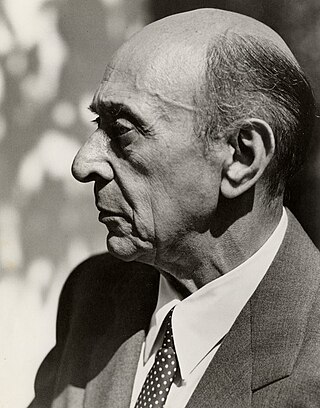
The twelve-tone technique—also known as dodecaphony, twelve-tone serialism, and twelve-note composition—is a method of musical composition first devised by Austrian composer Josef Matthias Hauer, who published his "law of the twelve tones" in 1919. In 1923, Arnold Schoenberg (1874–1951) developed his own, better-known version of 12-tone technique, which became associated with the "Second Viennese School" composers, who were the primary users of the technique in the first decades of its existence. The technique is a means of ensuring that all 12 notes of the chromatic scale are sounded as often as one another in a piece of music while preventing the emphasis of any one note through the use of tone rows, orderings of the 12 pitch classes. All 12 notes are thus given more or less equal importance, and the music avoids being in a key. Over time, the technique increased greatly in popularity and eventually became widely influential on 20th-century composers. Many important composers who had originally not subscribed to or actively opposed the technique, such as Aaron Copland and Igor Stravinsky, eventually adopted it in their music.
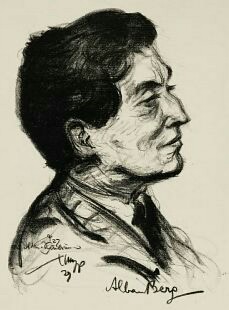
Alban Berg's Violin Concerto was written in 1935. It is probably Berg's best-known and most frequently performed piece. In it, Berg sought to reconcile diatonicism and dodecaphony. The work was commissioned by Louis Krasner, and dedicated by Berg to "the memory of an angel". It was the last work he completed. Krasner performed the solo part in the premiere at the Palau de la Música Catalana, Barcelona, in April 1936, four months after the composer's death.
An octatonic scale is any eight-note musical scale. However, the term most often refers to the ancohemitonic symmetric scale composed of alternating whole and half steps, as shown at right. In classical theory, this symmetrical scale is commonly called the octatonic scale, although there are a total of 43 enharmonically non-equivalent, transpositionally non-equivalent eight-note sets.
The String Quartet, Op. 28, by Anton Webern is written for the standard string quartet group of two violins, viola and cello. It was the last piece of chamber music that Webern wrote.
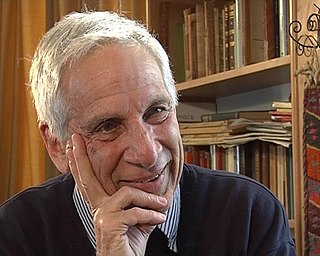
Peter Alexander Goehr is an English composer and academic.
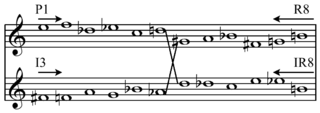
In music, a permutation (order) of a set is any ordering of the elements of that set. A specific arrangement of a set of discrete entities, or parameters, such as pitch, dynamics, or timbre. Different permutations may be related by transformation, through the application of zero or more operations, such as transposition, inversion, retrogradation, circular permutation, or multiplicative operations. These may produce reorderings of the members of the set, or may simply map the set onto itself.
In music, quartal harmony is the building of harmonic structures built from the intervals of the perfect fourth, the augmented fourth and the diminished fourth. For instance, a three-note quartal chord on C can be built by stacking perfect fourths, C–F–B♭.
Leopold Spinner was an Austrian-born, British-domiciled composer and editor.
The Petrushka chord is a recurring polytonal device used in Igor Stravinsky's ballet Petrushka and in later music. These two major triads, C major and F♯ major – a tritone apart – clash, "horribly with each other", when sounded together and create a dissonant chord.

The Symphony No. 4 in A minor, Op. 63, is a four-movement work for orchestra written from 1909 to 1911 by the Finnish composer Jean Sibelius.
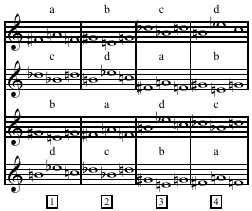
Composition for Four Instruments (1948) is an early serial music composition written by American composer Milton Babbitt. It is Babbitt's first published ensemble work, following shortly after his Three Compositions for Piano (1947). In both these pieces, Babbitt expands upon the methods of twelve-tone composition developed by Arnold Schoenberg. He is notably innovative for his application of serial techniques to rhythm. Composition for Four Instruments is considered one of the early examples of “totally serialized” music. It is remarkable for a strong sense of integration and concentration on its particular premises—qualities that caused Elliott Carter, upon first hearing it in 1951, to persuade New Music Edition to publish it.
Elegy for J.F.K. is a piece of vocal music composed by the Russian-born composer Igor Stravinsky in 1964, commemorating the assassination of U.S. President John F. Kennedy.
Requiem Canticles is a 15-minute composition by Igor Stravinsky, for contralto and bass soli, chorus, and orchestra. Stravinsky completed the work in 1966, and it received its first performance that same year.
In music, the "Ode-to-Napoleon" hexachord is the hexachord named after its use in the twelve-tone piece Ode to Napoleon Buonaparte Op. 41 (1942) by Arnold Schoenberg. Containing the pitch-classes 014589 it is given Forte number 6–20 in Allen Forte's taxonomic system. The primary form of the tone row used in the Ode allows the triads of G minor, E♭ minor, and B minor to easily appear.
6-Z44 (012569), known as the Schoenberg hexachord, is Arnold Schoenberg's signature hexachord, as one transposition contains the pitches [A], Es, C, H, B, E, G, E♭, B, and B♭ being Es, H, and B in German.
"Epitaphium" is a short chamber-music composition by Igor Stravinsky, for flute, clarinet, and harp. The score was composed in 1959 and is inscribed in German, "Für das Grabmal des Prinzen Max Egon zu Fürstenberg". A performance last for less than two minutes.
Aaron Copland wrote the Symphony for Organ and Orchestra in 1924. It represents a major work in the composer's oeuvre, as it was his first fully realized orchestral work, his first work for organ, and the first piece whose orchestration he heard. It was premiered on January 11, 1925, in New York. In 1928, Copland re-orchestrated the work without organ as his Symphony No. 1, rewriting the organ part in the brass and adding saxophone.